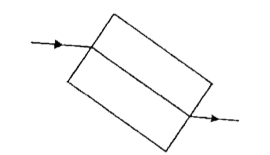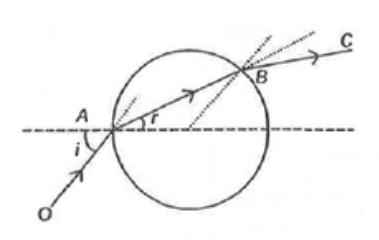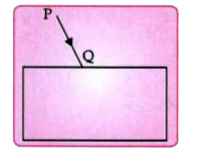The figure shows the path of a ray of light, through a rectangular glass block in a liquid of uniform density.
(a) Does the light speed up or slow down in glass ?
Give reason to your answer.
(b) What is angular deviation of the emergent ray from the glass block with respect to the incident ray ?
(c) Show with the help of ray diagram the path of the ray which incidents normally the the first surface of the glass block through the block and the liquid.

(d) What should be the ratio of the speed of light through the liquid to the speed through the glass so that there is no refraction of light at the boundaries of the glass when the system is illuminated by light of one colour ?
(e) What is the relation between angle of incidence i and angle of refraction r in the glass ?
(a) Light slows down in glass. Speed of light is maximum in air and is less in other denser mediums.
(b) The emergent ray is parallel to incident ray hence angular deviation is zero.

(c) If the light ray is incident normally on first face of the glass block it will go undeviated through the block as shown in figure.
(d) There will be no refraction if the velocity of light in the two mediums that is liquid and glass is equal.
(e) The relation is n=sinisinr.
Similar Questions
When a ray of light passes through a rectangular glass block, the direction of emergent ray is ___to the incident ray.
View SolutionDraw a labelled ray diagram to show the path of a ray of light incident obliquely on one face of a glass slab.
View SolutionA ray of light passes through a rectangular glass block placed in air. Which diagram shows a possible path of a ray?
 View Solution
View SolutionThe angle of deviation of emergent light ray (BC) with respect to incident ray (OA) on glass sphere Is, as shown in figure.
 View Solution
View SolutionThe angle of deviation of emergent light ray (BC) with respect to incident ray (OA) on glass sphere Is, as shown in figure.
 View Solution
View SolutionWhat is the angle of incidence if a ray of light is not deviated when it enters a block of glass ?
View SolutionDraw diagrams to show the refraction of light from (i) air to glass, and (ii) glass to air. In each diagram, label the incident ray, refracted ray, the angle of incidence (i) and the angle of refraction (r).
View SolutionIn the diagram below, PQ is a ray of light incident on a rectangular glass block.

How are the angles i and 'e' related to each other?View SolutionHow many refractions does a ray of light undergo on passing through a glass slab? What is the net deviation of the ray ?
View SolutionDraw a ray diagram showing refraction of a light ray from a refracting glass slab.
View Solution
